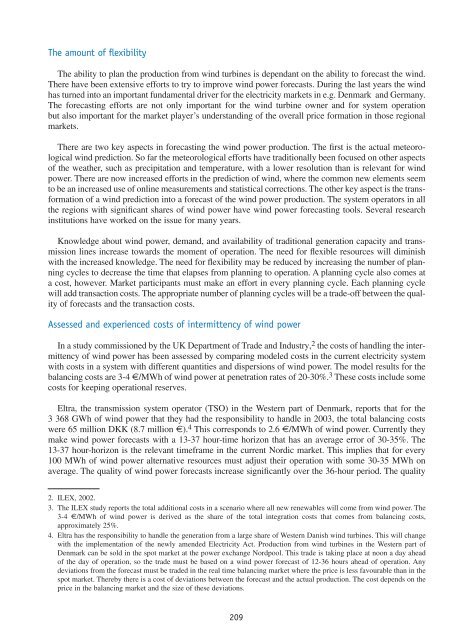Projected Costs of Generating Electricity - OECD Nuclear Energy ...
Projected Costs of Generating Electricity - OECD Nuclear Energy ...
Projected Costs of Generating Electricity - OECD Nuclear Energy ...
Create successful ePaper yourself
Turn your PDF publications into a flip-book with our unique Google optimized e-Paper software.
The amount <strong>of</strong> flexibility<br />
The ability to plan the production from wind turbines is dependant on the ability to forecast the wind.<br />
There have been extensive efforts to try to improve wind power forecasts. During the last years the wind<br />
has turned into an important fundamental driver for the electricity markets in e.g. Denmark and Germany.<br />
The forecasting efforts are not only important for the wind turbine owner and for system operation<br />
but also important for the market player’s understanding <strong>of</strong> the overall price formation in those regional<br />
markets.<br />
There are two key aspects in forecasting the wind power production. The first is the actual meteorological<br />
wind prediction. So far the meteorological efforts have traditionally been focused on other aspects<br />
<strong>of</strong> the weather, such as precipitation and temperature, with a lower resolution than is relevant for wind<br />
power. There are now increased efforts in the prediction <strong>of</strong> wind, where the common new elements seem<br />
to be an increased use <strong>of</strong> online measurements and statistical corrections. The other key aspect is the transformation<br />
<strong>of</strong> a wind prediction into a forecast <strong>of</strong> the wind power production. The system operators in all<br />
the regions with significant shares <strong>of</strong> wind power have wind power forecasting tools. Several research<br />
institutions have worked on the issue for many years.<br />
Knowledge about wind power, demand, and availability <strong>of</strong> traditional generation capacity and transmission<br />
lines increase towards the moment <strong>of</strong> operation. The need for flexible resources will diminish<br />
with the increased knowledge. The need for flexibility may be reduced by increasing the number <strong>of</strong> planning<br />
cycles to decrease the time that elapses from planning to operation. A planning cycle also comes at<br />
a cost, however. Market participants must make an effort in every planning cycle. Each planning cycle<br />
will add transaction costs. The appropriate number <strong>of</strong> planning cycles will be a trade-<strong>of</strong>f between the quality<br />
<strong>of</strong> forecasts and the transaction costs.<br />
Assessed and experienced costs <strong>of</strong> intermittency <strong>of</strong> wind power<br />
In a study commissioned by the UK Department <strong>of</strong> Trade and Industry, 2 the costs <strong>of</strong> handling the intermittency<br />
<strong>of</strong> wind power has been assessed by comparing modeled costs in the current electricity system<br />
with costs in a system with different quantities and dispersions <strong>of</strong> wind power. The model results for the<br />
balancing costs are 3-4 €/MWh <strong>of</strong> wind power at penetration rates <strong>of</strong> 20-30%. 3 These costs include some<br />
costs for keeping operational reserves.<br />
Eltra, the transmission system operator (TSO) in the Western part <strong>of</strong> Denmark, reports that for the<br />
3 368 GWh <strong>of</strong> wind power that they had the responsibility to handle in 2003, the total balancing costs<br />
were 65 million DKK (8.7 million €). 4 This corresponds to 2.6 €/MWh <strong>of</strong> wind power. Currently they<br />
make wind power forecasts with a 13-37 hour-time horizon that has an average error <strong>of</strong> 30-35%. The<br />
13-37 hour-horizon is the relevant timeframe in the current Nordic market. This implies that for every<br />
100 MWh <strong>of</strong> wind power alternative resources must adjust their operation with some 30-35 MWh on<br />
average. The quality <strong>of</strong> wind power forecasts increase significantly over the 36-hour period. The quality<br />
2. ILEX, 2002.<br />
3. The ILEX study reports the total additional costs in a scenario where all new renewables will come from wind power. The<br />
3-4 €/MWh <strong>of</strong> wind power is derived as the share <strong>of</strong> the total integration costs that comes from balancing costs,<br />
approximately 25%.<br />
4. Eltra has the responsibility to handle the generation from a large share <strong>of</strong> Western Danish wind turbines. This will change<br />
with the implementation <strong>of</strong> the newly amended <strong>Electricity</strong> Act. Production from wind turbines in the Western part <strong>of</strong><br />
Denmark can be sold in the spot market at the power exchange Nordpool. This trade is taking place at noon a day ahead<br />
<strong>of</strong> the day <strong>of</strong> operation, so the trade must be based on a wind power forecast <strong>of</strong> 12-36 hours ahead <strong>of</strong> operation. Any<br />
deviations from the forecast must be traded in the real time balancing market where the price is less favourable than in the<br />
spot market. Thereby there is a cost <strong>of</strong> deviations between the forecast and the actual production. The cost depends on the<br />
price in the balancing market and the size <strong>of</strong> these deviations.<br />
209

















